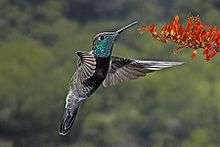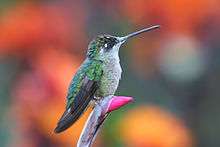Rivoli's hummingbird
| Rivoli's hummingbird | |
|---|---|
 | |
| Male | |
 | |
| Female | |
| Scientific classification | |
| Kingdom: | Animalia |
| Phylum: | Chordata |
| Class: | Aves |
| Order: | Apodiformes |
| Family: | Trochilidae |
| Genus: | Eugenes |
| Species: | E. fulgens |
| Binomial name | |
| Eugenes fulgens (Swainson, 1827) | |
Rivoli's hummingbird (Eugenes fulgens) is a large hummingbird. It was usually considered the only member of the genus Eugenes, and is also called the magnificent hummingbird. Many taxonomic authorities, such as the International Ornithological Committee, split the northern, nominate subspecies E. f. fulgens from the larger, southern race of Costa Rica and Panama, E. f. spectabilis, as distinct species,[2] in which case the nominate fulgens is renamed Rivoli's hummingbird, and spectabilis is named the Talamanca hummingbird.
Distribution and habitat

Rivoli's hummingbird breeds in mountains from the southwestern United States to Honduras and Nicaragua. It inhabits the edges and clearings of montane oak forests from about 2000 m altitude up to the timberline. During the breeding season they live around ravines in mountain areas of southern Arizona and New Mexico. They feed in open meadows where flowers are abundant.[3]
Description
Rivoli's hummingbird species ranges from 11–14 cm (4.3–5.5 in) in length and weighs from 6 to 10 g (0.21 to 0.35 oz), with males typically a little larger than females.[2][3] Of the hummingbirds found in the United States, Rivoli's hummingbird is one of the two largest species, rivaled in size only by the blue-throated hummingbird. The black bill is long and straight to slightly curved. Both sexes look very dark unless the sun catches the iridescence of the plumage and the brilliant colours flash in the sunlight.
The adult male is green-bronze dorsally, becoming more bronzed on the black-tipped tail. The crown is violet, the throat gorget bright blue-green, and the rest of the head black apart from a white spot behind the eye. The chest is green-bronze and the belly grayish. The female is bronze-green dorsally and has a dull grey ventral colouring. There is a white stripe behind her eye. Immature birds are like the female, but darker and browner.
Behavior
In the southern reaches of its range, Rivoli's hummingbird may coexist or even cross-breed with other hummingbird species of comparable or slightly larger size.[3] The female Rivoli's hummingbird is entirely responsible for nest building and incubation. She lays two white eggs in her bulky cup nest about 3 metres up near the tip of a descending branch stem. Incubation takes 15–19 days, and fledging another 20–26.
The food of this species is nectar, taken from a variety of flowers, and some small insects. Rivoli's hummingbird males perch conspicuously and defend their feeding territories aggressively. The call is a guttural drrrk.
Nesting
The female builds a nest high in trees often overhanging streams.[3] The nest is an open cup lined with soft feathers, mosses and small leaves.[3] The exterior, covered with lichen and other plant litter bound with spider silk, measures 2.2 inches (5.6 cm) wide and 1.8 inches (4.6 cm) deep, with the inner cup 1.4 inches (3.6 cm) wide and 1 inch (2.5 cm) deep.[3]
References
- ↑ BirdLife International (2012). "Eugenes fulgens". IUCN Red List of Threatened Species. Version 2013.2. International Union for Conservation of Nature. Retrieved 26 November 2013.
- 1 2 Powers, Donald R. (25 October 2013). Poole, A, ed. "Magnificent hummingbird (Eugenes fulgens)". The Birds of North America Online. Cornell Lab of Ornithology. doi:10.2173/bna.221. Retrieved 16 April 2017.
- 1 2 3 4 5 6 "Magnificent hummingbird". The Cornell Lab of Ornithology, Cornell University, Ithaca, NY. 2015. Retrieved 16 April 2017.
External links


